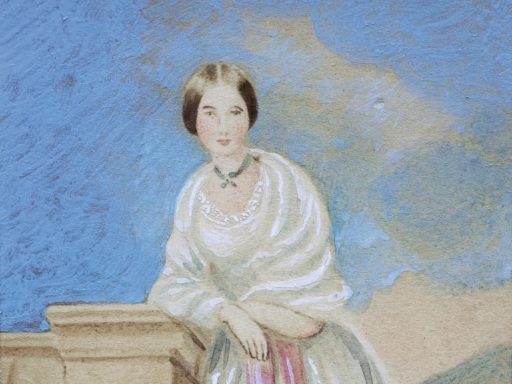The Farnborough Air Show is a biennial jamboree that’s actually more market place than show. It’s where you come to buy aircraft or satellites or spare parts or just about anything you might need if your business is about flying high. But this year I abandoned the trade halls to watch the Avro Vulcan XH558 bomber take off – its Olympus engines howling like no other jet, and then land, having thrilled the crowds with a beautiful, graceful and yes – […]
Our world-class collection forms an enduring record of scientific, technological and medical achievements from across the globe. Come behind the scenes as we explore new object acquisitions and meet the conservation team.
Today in 1839, John Herschel made the first photograph on glass. The plate, with the image now faded almost beyond recognition, is in the care of our colleagues at the National Media Museum. The image was of the 40ft telescope built by John’s father William, something of a tourist attraction due to its size. By the time this photograph was taken only the telescope support frame remained, with the tube already removed – the structure had begun to rot after […]
In Britain, closure of public toilets has become a cause célèbre in recent years. Such facilities first appeared in numbers following the Public Health Act of 1848. But many of these older sites and their modern counterparts – regularly vandalised and expensive to maintain – have closed their doors. Yet while these often substantial buildings still survive, albeit boarded up or changed in use, most of the old simple public urinals have long gone. This is less true in other parts of […]
Before my first visit to the Science Museum’s stores, I’d imagined having to search for my mysterious magnetic instruments in the midst of much dust and cobwebs in the warehouse from the closing scenes of Citizen Kane. In the rather more ordered and hermetically sealed rooms of Blythe House, the spider threads I found were of a much cosier sort. Encased in their own tiny frame, they rather reminded me of my great-grandparents in their wedding portrait. The two cocoons […]
I’ve recently returned from a fortnight’s holiday in Belgium (….a terribly underrated destination – no, really). While there, I persuaded my family to spend time exploring the World War One battlefields around Ypres. I was particularly interested in surviving evidence of frontline medical services. This was once an Advanced Dressing Station (ADS), at a site known as Essex Farm. One of the largest surviving groups of military buildings in the area, these damp, claustrophobic structures were comparatively comfortable. Built in 1916, […]
As a warm up for Ask a Curator day tomorrow, I thought I would give you an in-depth look at one of our objects that has been generating a lot of comments on Twitter. You may remember a post by my colleague, Stewart, on Arms, legs and ex-Servicemen showing our 20th century collection of prosthetic limbs. The history of artificial limbs is inseparable from the history of amputations and closely linked to warfare. This artificial arm was made for someone who had their left arm amputated above […]
Is there a burning question that you’d like to ask a curator? Maybe what’s your favourite object? What’s the tiniest object in your collection? How do you go to the loo in space? Well now’s your chance, because 1 September is ‘Ask a Curator Day’ – a unique worldwide Q&A session which lets you put questions to museums. A crack team of Science Museum curators and other staff members will be standing by – so start thinking now. All you have to […]
A couple of weeks ago I talked about how we got the aircraft into our Flight gallery, in response to a Twitter question. I said I’d been to our photo archive to see if we had any pictures of the 1960s aircraft installation, and I turned up lots of great images. Well, the scans have just arrived, so for those interested in how to get a Supermarine S6B world-speed-record-breaking aeroplane into a third-floor gallery in central London in 1961, here goes… […]

Selina Hurley explores the life and work of Florence Nightingale, the Lady with the Lamp.
James Watt died 191 years ago today. He was considered one of the most important engineers in the country, and after his death he was turned into a national hero. The result was a slew of statues, memorials and paintings – some of which will go on show in a new exhibition opening in spring 2011. More details to follow… When Watt was 59, his friend and partner Matthew Boulton introduced him to Carl von Breda, who painted the earliest portrait that that Watt was […]
Increasing public access to our collections is one of our main priorities. But what do you do when so many of your objects are in storage? Our medical collections are built on the legacy of Victorian entrepreneur Henry Wellcome. He was a millionaire who collected far, wide and en masse. Even our main, highly object-rich medical gallery can only contain a small fraction of the vast number of objects we look after. At our London store, over 40 rooms are devoted […]
One of the highlights of a visit to Wells Cathedral is seeing the oldest surviving clock face in the world, in the north transept. Above the face, jousting knights on horseback do battle, with one unfortunate being knocked over. Looking on, a figure called Jack Blandifer chimes bells each quarter-hour. Originally the knights charged every hour, but due to tourist demand the display was modified in the 1960s to allow a shorter joust to happen every 15 minutes. The knights […]